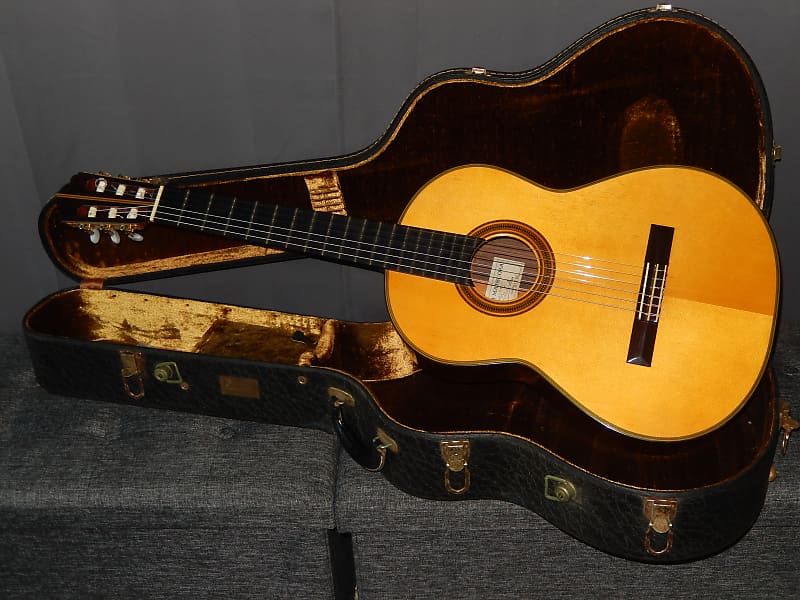

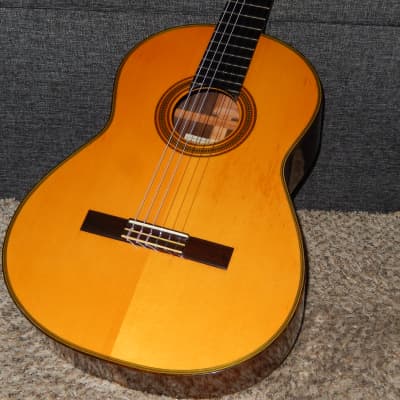
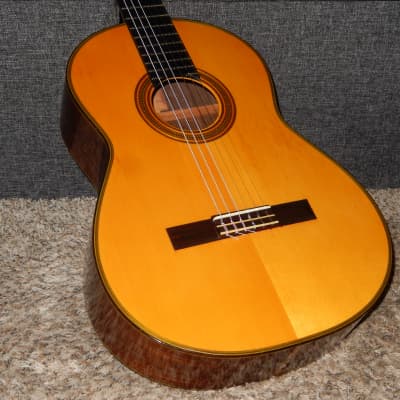
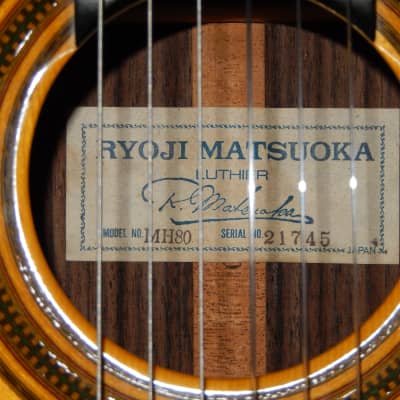
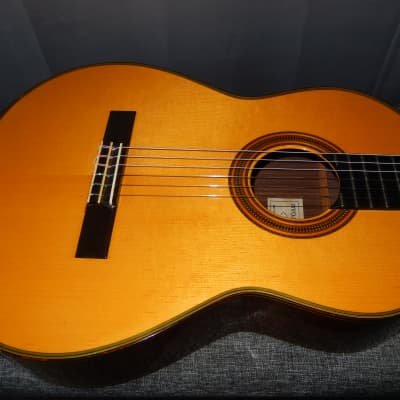
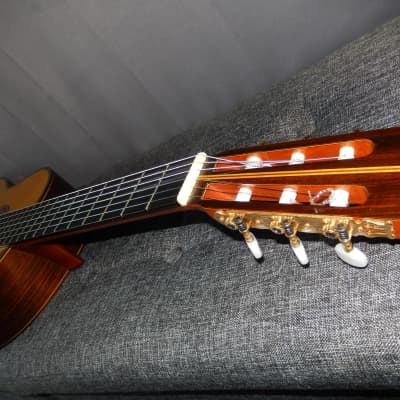
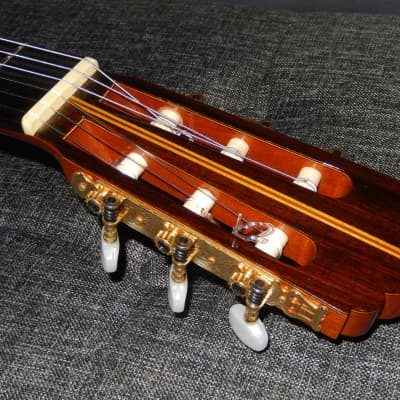
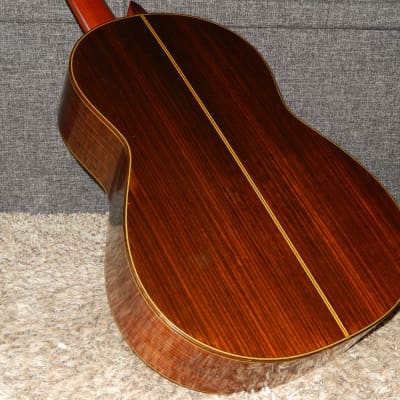
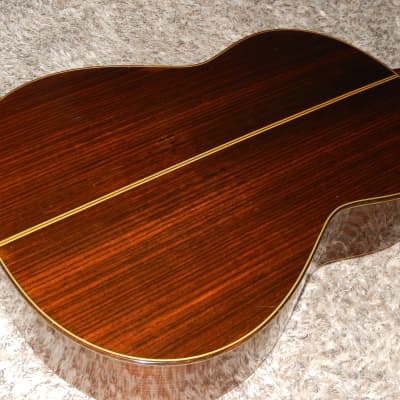
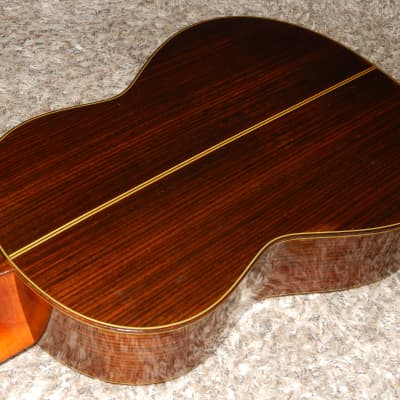
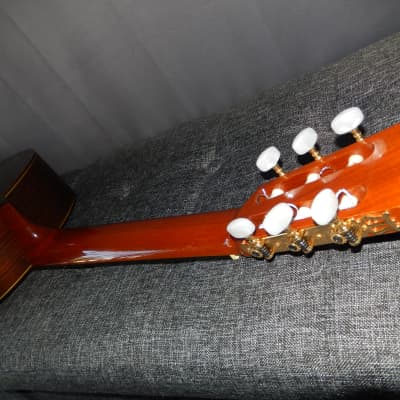
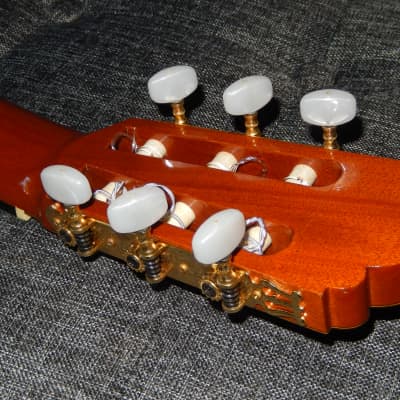
Several hundred guitars I have sold in the past are presented at Facebook.com/Victors.Guitar.Library.
R.Matsuoka MH80 1981
This guitar was handmade and signed by Master Luthier Ryoji Matsuoka in 1981. It is an instrument of much higher grade than models MH80 made in later years. Being priced 80 000 yen it was way underpriced if compared with instruments made by leading Japanese luthiers of that era. Since the very beginning of Ryoji's career his guitars have always offered exceptional value to all guitar lovers. It was all possible thanks to his business philosophy and a team of very skilled luthiers working under his supervision.
By the end of 1970s, due to significant changes in world's economy and currency exchange rates, all Japanese Gakkis had to redesign their guitar lineups and adjust their prices in order to remain competitive on international markets and still make profits. Higher end models became more expensive, while mid-range models were made with lower grade materials and had simpler construction if compared with "similarly labelled" models made during 1970s. This MH80 guitar is of much higher grade than Matsuoka's model MH80 made in 1985, or MH100 made in 1990 or MH150 made in 1995.
Although this guitar is still in very good functional condition, its surfaces bear multiple minor cosmetic imperfections (multiple fingernail marks on its top, some light scratches on its back and the back of its neck, and some light abrasions along its edges). Yet the condition of its fingerboard and frets suggest that this guitar hasn’t been played a lot.
Despite all of these “damages” this is highly valuable musical instrument that produces gorgeous sound.
It was made basing on Hauser blueprint.
The guitar offers exceptional volume and response, very deep, somewhat metallic and full of overtones basses, super sweet trebles, all well balanced, with superb note clarity and separation and very extended sustain.
Similar grade guitars currently made by Japanese luthiers are priced at least $6000. Similar grade guitars currently made in Spain are priced at least $8000.
Specification:
* Solid Spruce Top with Hauser style bracing (asymmetrical fan of 7 braces)
* Solid Indian Rosewood back and sides
* Mahogany neck
* Ebony fingerboard
* Rosewood Bridge
* Bone nut and saddles
* Nut width: 52mm
* Scale: 650 mm
* Gold hardware
The action is set to 4.00 mm under E6 and 3.50 mm under E1 with still some extra room on the saddle
This guitar will be shipped in used hard shell case in still usable condition but of minimal value.
REAL VALUE OF JAPANESE VINTAGE GUITARS
The key to understand value of vintage Japanese guitars is to acknowledge galloping price inflation (devaluation of Japanese yen) during 1960s & 1970s. This inflation slowed down in 1980s.
During 1960s and most of 1970s model numbers of Japanese guitars were strictly interconnected with their prices in Japanese yen. By early 1980s and during following decades model numbers were no longer strictly associated with their prices. Some Japanese guitar makers introduced model names instead of model numbers. Others were still using model numbers with addition of letters and/or other symbols.
It is then important to understand that two Yamaha GC10 guitars made 10 years apart are two instruments of totally different class. The same applies to any other Japanese maker/brand.
The logical way to estimate the true class of any given Japanese made instrument is to compare its price with the average annual salary of wage workers in Japanese private sectors. This salary was: 450 600 yen in 1965 - 825 900 yen in 1970 - 1 868 300 yen in 1975 - 2 689 000 yen in 1980 - 3 163 000 yen in 1985 - 3 761 000 yen in 1990 - 4 107 000 yen in 1995 - 4 082 000 yen in 2000.
Any guitar priced 100 000 yen in 1970 (labelled as No10 or No100) would be priced 200 000 yen in 1975 (relabeled to No20, No200 or 2000), 300 000 yen in 1977 (labelled as No3, No30 or 3000) and 500 000 yen by 1985 (labelled as No50 or 5000).
Starting in 1977 Masaru Kohno introduced his new models No40 priced 400 000 yen and No50 priced 500 000 yen. By early 1980s Kohno started using model names instead of numbers and was steadily raising their prices without changing model labeling. His very top model 50 became model “Special”, and a decade later it became model “Maestro”. Naturally, all other Japanese guitar makers were doing similar pricing (labelling) upgrades.
Knowing all of that, you can bet on that Masaru Kohno No50 made in 1982 is practically the same grade instrument as Kohno No20 made in 1972, or Kohno no 30 made in 1975.
In early 1970s the lowest Ryoji Matsuoka (all plywood) model was 10, followed by (solid top) models 15, 20, 25, 30, 40, 50, 60, 80 and (all solid woods) models 100 and 150. Models 50, 60 and 80 were made with non-solid figured Brazilian Rosewood (double) back and sides and top model 150 was the only one made with solid figured Brazilian Rosewood b/s.
In 1980 the lowest Matsuoka model was (all plywood) 20, followed by (solid top) models 30,40,50, 60 and all solid woods models 80,100,150 and 200. By 1990 the lowest Matsuoka model was M40 and the highest was M300. By 2010 the lowest Matsuoka model was M50 and the top model was M270.
You can bet that Ryoji Matsuoka model 50 from 1980 is of the same grade as model M100 from 2000, model 100 from 1980 is of the same grade as model M150 from 2000, model 150 from 1980 is of the same grade as M200 from 2000 and model 200 from 1980 is of the same grade as model M300 from 2000.
It is important to mention that if modern era luthiers are using 40+ years old woods to make an “all solid” wood classical guitar, its price is minimum $8000.
All vintage guitars made with Brazilian Rosewood are especially precious, including those made straight grain varieties and those with non-solid b/s.
Because response and tonal properties of Spruce soundboards are improving over time, long seasoned Spruces are far more precious than long seasoned Cedars.
It is not very difficult to find out what are current prices of such guitars made by world’s leading luthiers.
Important message for Australian buyers:
USPS International Priority Mail packages destined for Australia have quite restricted size (max. length is 42” and max. length + girth is 97”). For these reasons I must use the case that is no longer than 41” and therefore it may be different than the one you see on the pictures. You should ask me for any other details prior to making a purchase.
| Listed | 3 years ago |
| Condition | Very Good (Used) Very Good items may show a few slight marks or scratches but are fully functional and in overall great shape.Learn more |
| Brand | |
| Model |
|
| Finish |
|
| Categories | |
| Year |
|
| Made In |
|
| Body Shape |
|
